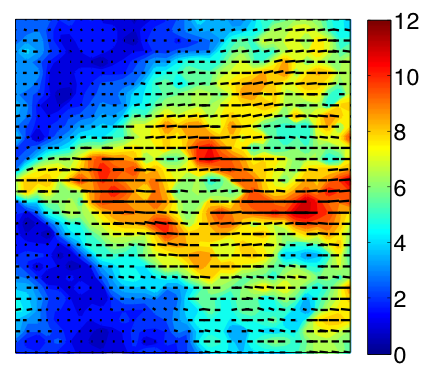Interstellar and Circumgalactic Medium
In the UV, a wealth of absorption features arises from the interstellar medium (ISM) observed toward hot stars, or from the circumgalactic/intergalactic medium (CGM, IGM,
respectively) observed toward quasars, yielding fundamental insights on chemical abundances, kinematics, and polarization of the gas across a wide range of environments.
POLLUX will, for the first time, give access to all ISM phases at the same required high spectral resolution R>120,000. It will enable simultaneous study of tracers of hot-gas (O VI, C IV..), warm gas (O I, N I and many singly-ionized species), as well as cold-H I gas like C I, and of the molecular phases through H2 and CO lines. Together with the superior sensitivity reached by LUVOIR, this will open up a wide discovery space (some of it summarized in Jenkins & Wallerstein 1999), in particular (1) the dissipation of turbulence, the formation of H2, and the role of H2 as a coolant, through velocity-resolved H2, CO, CH, CH+... profiles in various rotational and vibrational levels, (2) the properties of cooling layers behind radiative shock fronts and the associated time-dependent ionization scheme through weak high-velocity components of S III, Si IV and C IV, (3) the interplay between energetic sources and the ISM through detailed ionization structure of the partly-ionized neutral gas and of the warm ionized gas (e.g., Gry & Jenkins 2017), (4) the identification and properties of tiny-scale (101-4 AU) atomic structures (Heiles et al. 1997; Stanimirović & Zweibel 2018) through tracking of spatial and temporal absorption variations, (5) the understanding of basic processes such as the H0-to-H2 and C0-to-CO transitions, and the CO/H2 ratio by reaching for the first time truly molecular clouds (AV > ~5) where the chemistry is influenced by cosmic rays.
A revolutionary aspect of POLLUX is the possibility to study the magnetic field structure in relation with potentially all the ISM phases through the measurement of linear polarization of optically-thin UV absorption lines. Ground state alignment occurs when optical/UV pumping transfers angular momentum from the radiation field to the atoms/ions (Yan & Lazarian 2006), allowing us to trace 3D direction of magnetic field and to examine the specific role of magnetic fields in star/disk formation and, in general, in regulating the mass and energy circulation between stars and the ISM. Furthermore, unlike dust polarization measurements, POLLUX gives access to 3D magnetic field tomography by measuring its orientation in different locations along the lines of sight, on small spatial scales, and from multiple lines. Given the level of polarization expected, a signal-to-noise ratio of a few hundreds is required (see Figure).
The various phases of the ISM
Matter in the ISM is distributed in diverse, but well-defined phases that consist of the hot (T ~ 106-7 K) ionized medium, the warm (6000 - 104 K) neutral or ionized medium, and the cold (10 – 200 K) neutral medium and molecular clouds (e.g., McKee & Ostriker 1977; Cox 2005). Boundaries between phases can be quite abrupt and are believed to play a critical role in cooling the hot material, although it is not yet clear how they trade matter and entropy. Thermal conduction and turbulent mixing are, for instance, still poorly understood (e.g., Slavin et al. 1993 ; Scalo & Elmegreen 2004).POLLUX will, for the first time, give access to all ISM phases at the same required high spectral resolution R>120,000. It will enable simultaneous study of tracers of hot-gas (O VI, C IV..), warm gas (O I, N I and many singly-ionized species), as well as cold-H I gas like C I, and of the molecular phases through H2 and CO lines. Together with the superior sensitivity reached by LUVOIR, this will open up a wide discovery space (some of it summarized in Jenkins & Wallerstein 1999), in particular (1) the dissipation of turbulence, the formation of H2, and the role of H2 as a coolant, through velocity-resolved H2, CO, CH, CH+... profiles in various rotational and vibrational levels, (2) the properties of cooling layers behind radiative shock fronts and the associated time-dependent ionization scheme through weak high-velocity components of S III, Si IV and C IV, (3) the interplay between energetic sources and the ISM through detailed ionization structure of the partly-ionized neutral gas and of the warm ionized gas (e.g., Gry & Jenkins 2017), (4) the identification and properties of tiny-scale (101-4 AU) atomic structures (Heiles et al. 1997; Stanimirović & Zweibel 2018) through tracking of spatial and temporal absorption variations, (5) the understanding of basic processes such as the H0-to-H2 and C0-to-CO transitions, and the CO/H2 ratio by reaching for the first time truly molecular clouds (AV > ~5) where the chemistry is influenced by cosmic rays.
A revolutionary aspect of POLLUX is the possibility to study the magnetic field structure in relation with potentially all the ISM phases through the measurement of linear polarization of optically-thin UV absorption lines. Ground state alignment occurs when optical/UV pumping transfers angular momentum from the radiation field to the atoms/ions (Yan & Lazarian 2006), allowing us to trace 3D direction of magnetic field and to examine the specific role of magnetic fields in star/disk formation and, in general, in regulating the mass and energy circulation between stars and the ISM. Furthermore, unlike dust polarization measurements, POLLUX gives access to 3D magnetic field tomography by measuring its orientation in different locations along the lines of sight, on small spatial scales, and from multiple lines. Given the level of polarization expected, a signal-to-noise ratio of a few hundreds is required (see Figure).
Extragalactic ISM
Beyond the Milky Way ISM, an important prospect for future UV observatories is to explore different environments. As such, LUVOIR is expected to extend the same level of detailed physical studies available in the Milky Way ISM to the ISM in external galaxies, in particular those with low metallicity or strong evidence of gas exchange with the IGM. In the UV, apart from a few lines of sight toward individual stars in the Magellanic Clouds, the extragalactic ISM has been mostly observed toward stellar clusters and at low spectral resolution, with inherent biases for column density determination (non-linear combination of column densities, “hidden” saturation, and mixed interstellar absorption and nebular emission along kpc-long lines of sight; e.g., Lebouteiller et al. 2013). LUVOIR and POLLUX will solve these technical issues, providing for the first time detailed and reliable knowledge of (1) the dust production/composition through depletion patterns, (2) the interplay between the ISM and compact sources, (3) the molecular gas content and distribution (H2 clumps at ~pc size), (4) chemical abundance variations in different phases, and (5) the role of infalling and outflowing gas in the metallicity buildup.CGM: the link between galaxies and the large-scale cosmological component
No model of galaxy formation and evolution is complete without considering gas flows around galaxies, in particular in the CGM. The CGM is characterized by its extreme multi-phase nature consisting of cold neutral/molecular gas clumps embedded in diffuse, highly-ionized gas filaments, with wide temperature (50 – 5×106 K) and density (10-5 - 100 cm-3) ranges (e.g., Richter 2017; Tumlinson et al. 2017). High spectral resolution is necessary to disentangle the various components and to resolve the line thermal broadening while high sensitivity is required to increase the number of quasar lines of sight per halo that can probe the CGM of many galaxies at various redshifts. POLLUX will make it possible to probe gas flows, to map the distribution of metals, and, in general, to understand the role of CGM clouds in galaxy formation and evolution. Going back full circle, some of these questions can also be studied by observing the CGM of our own Milky Way toward a large sample of halo stars with known distances. Are CGM clouds disrupted and incorporated into the halo coronal gas or do they reach the disk where they can fuel star formation? It is worth noting that UV observations are well adapted to the measurement of much lower HI column densities (<~1013 cm-2; Lehner et al. 2006) than those accessed with 21cm observations. |
Synthetic polarization (%) map of the simulated diffuse ISM (1pc2). A O/B star is located 0.1pc at the left center. Contour color: percentage of polarization in the SII 1250 A absorption line. Orientation of the bars: polarization direction. Mean magnetic field = 3 μG, oriented along the X-axis. This figure shows that the direction of polarization correctly indicates the magnetic field direction and that the expected polarization is mostly above 5%, within POLLUX capabilities. |

